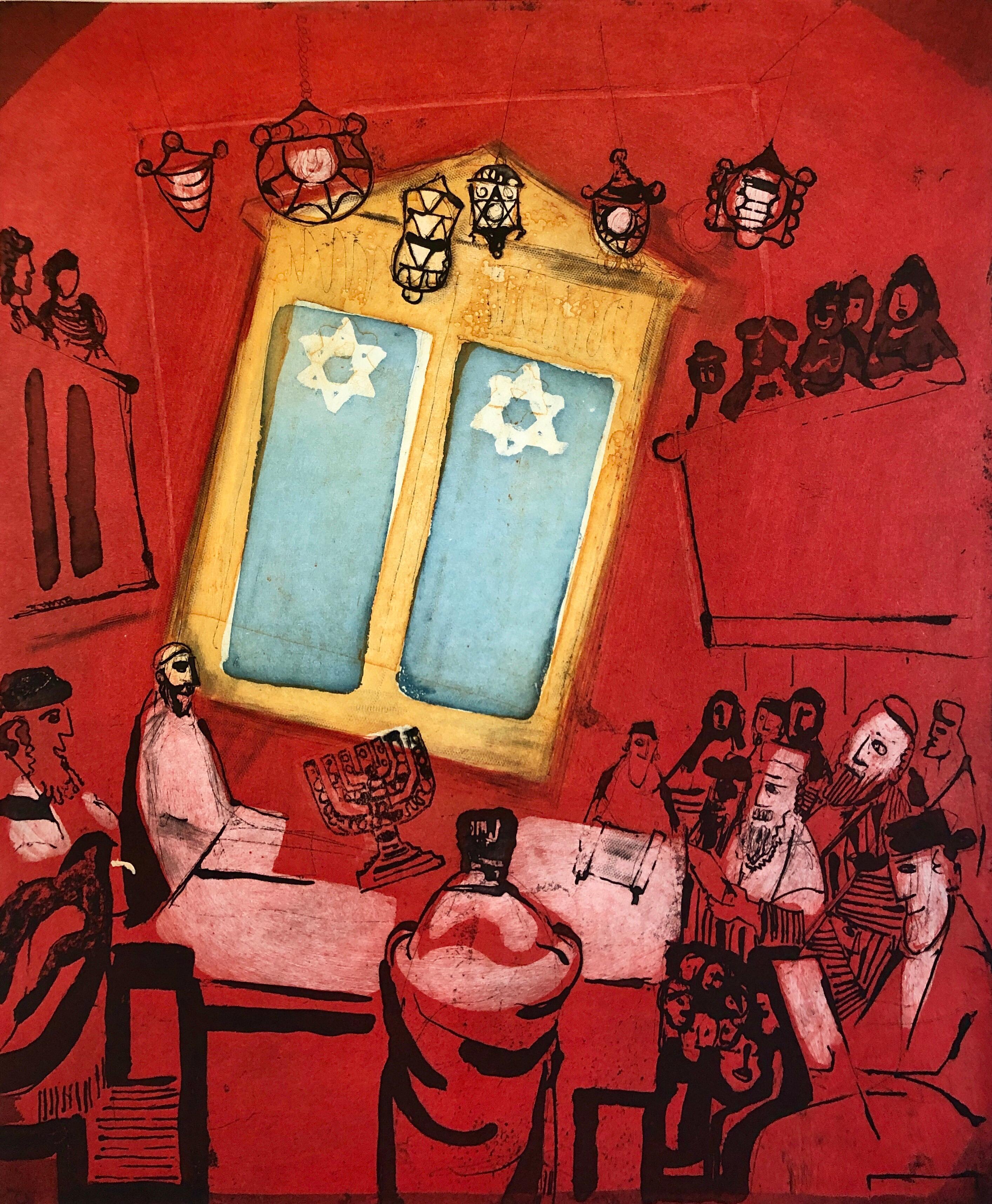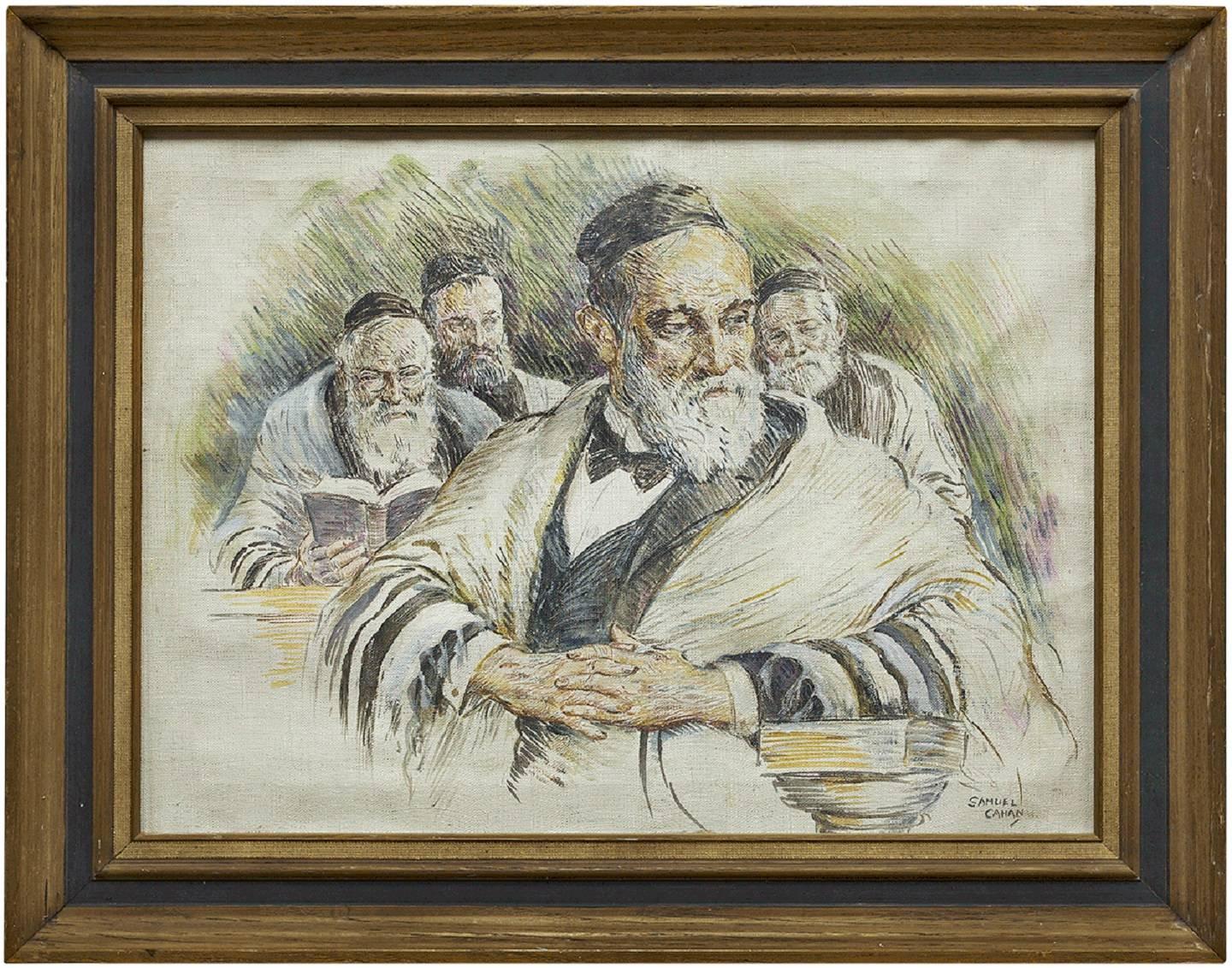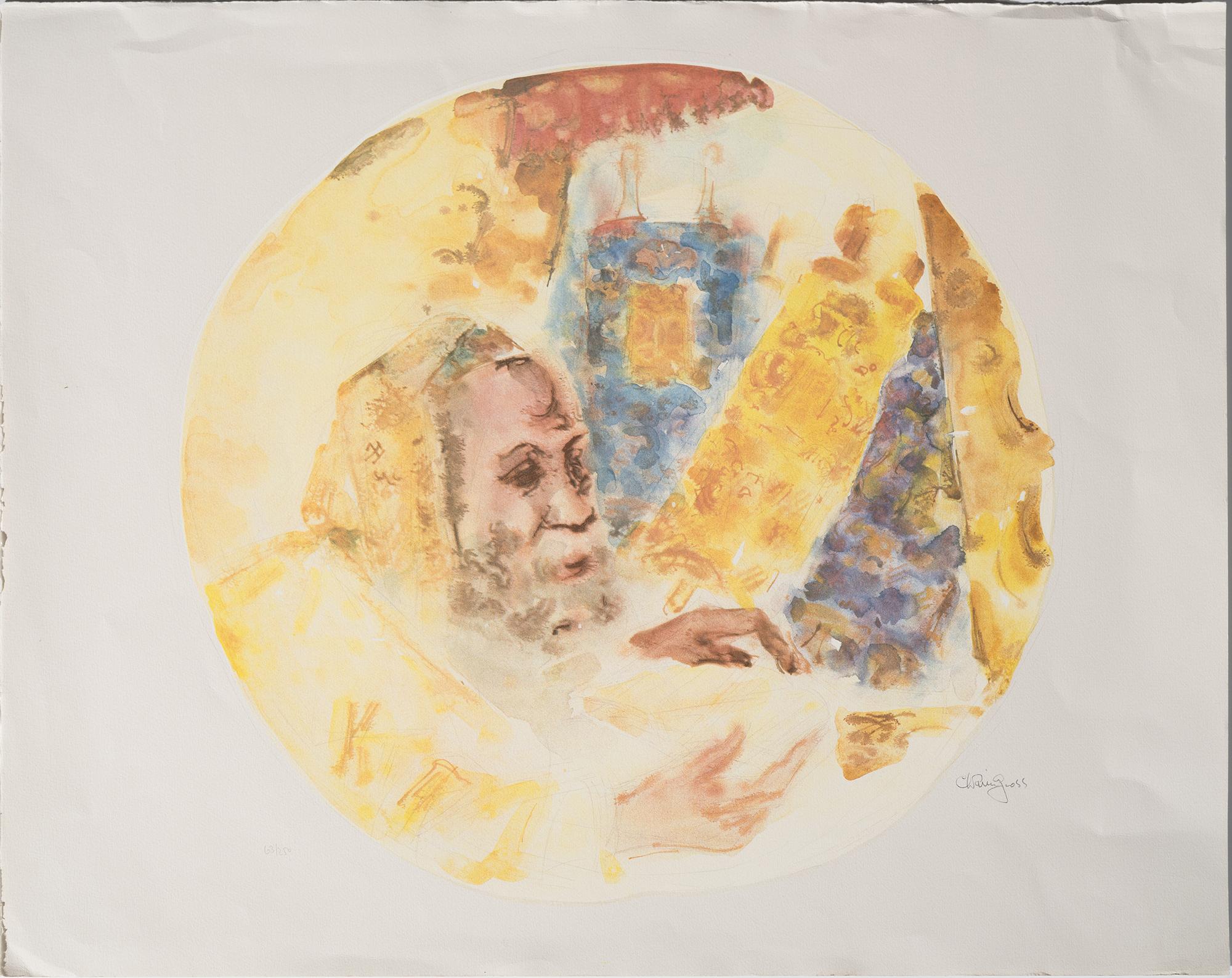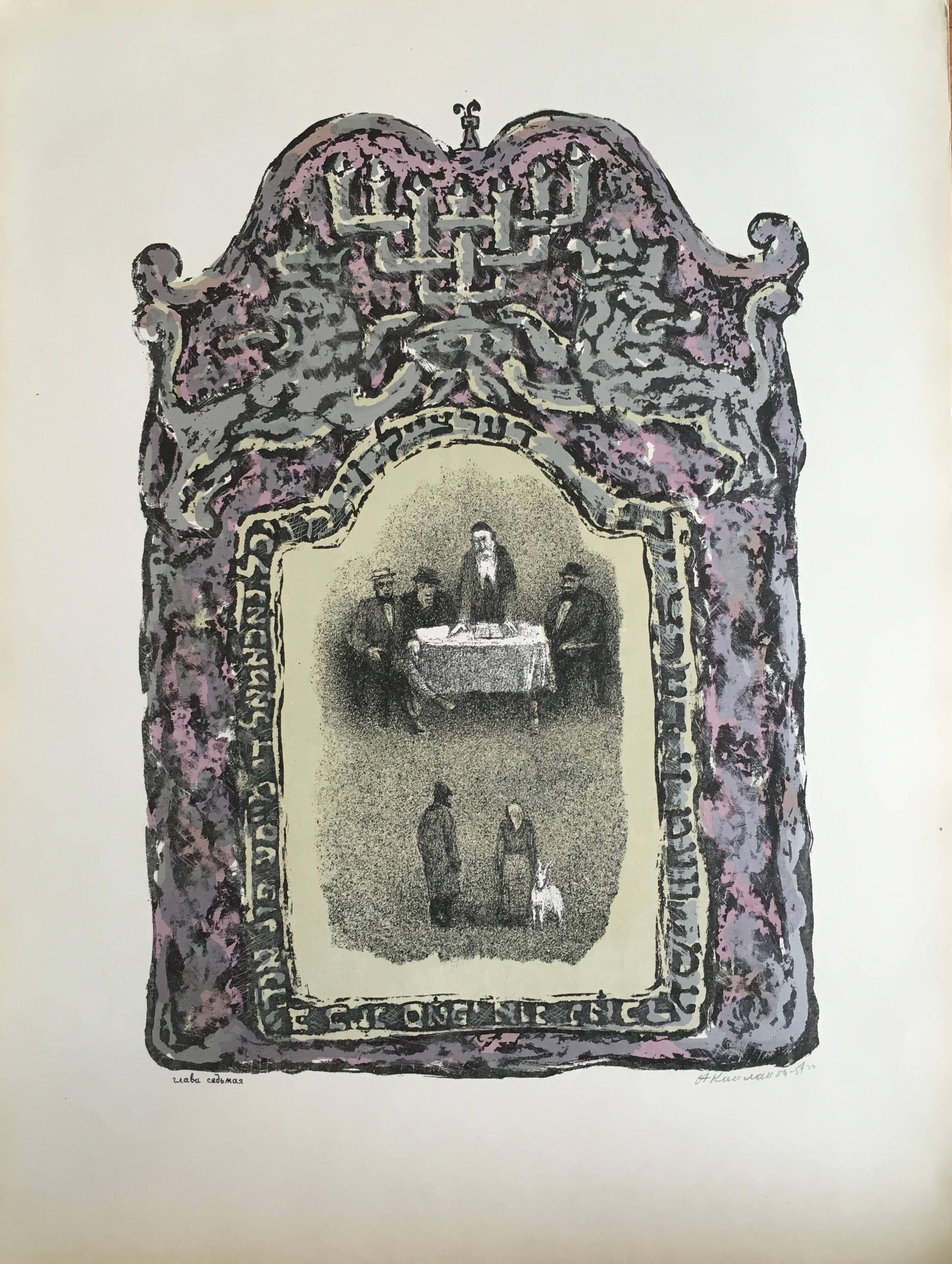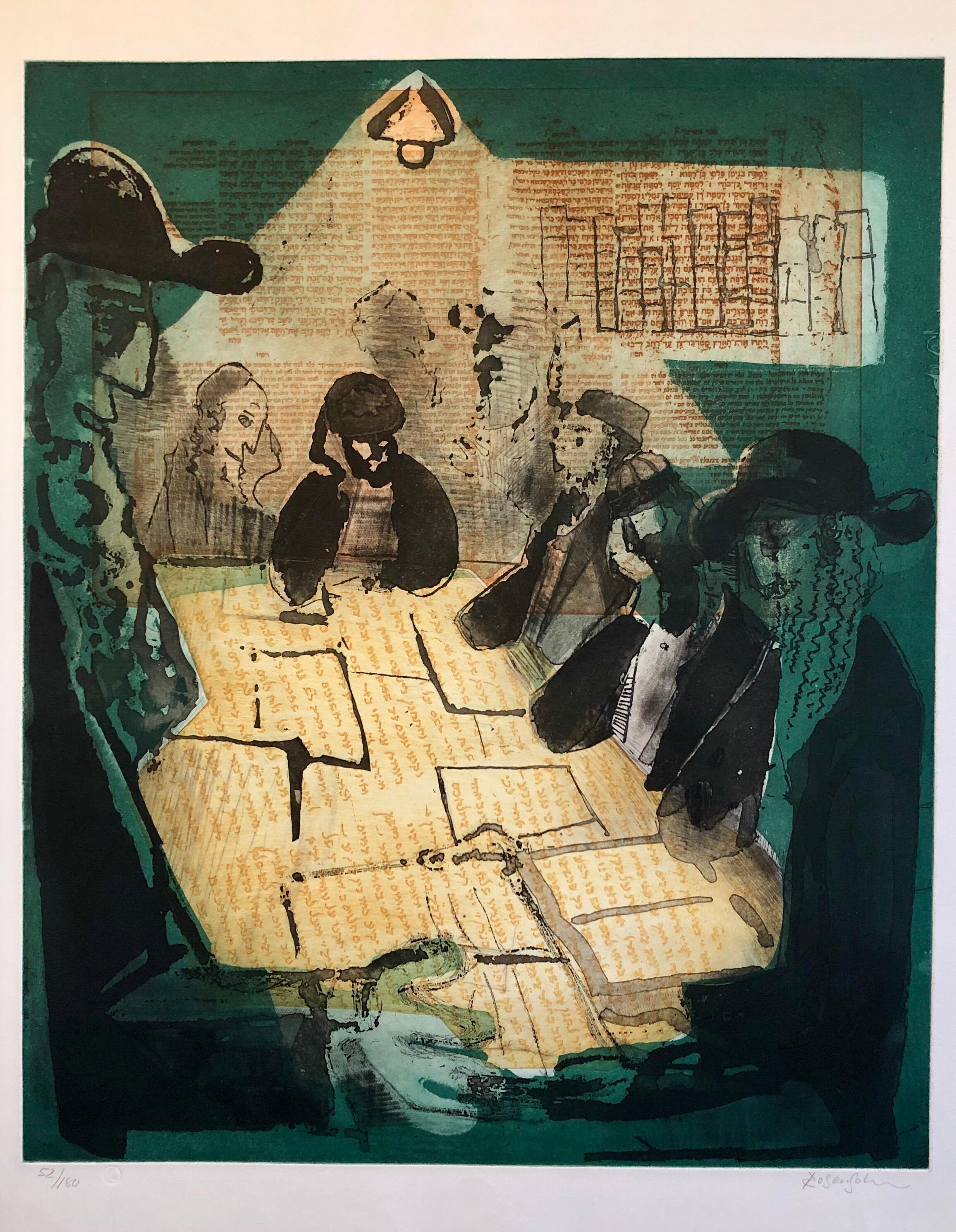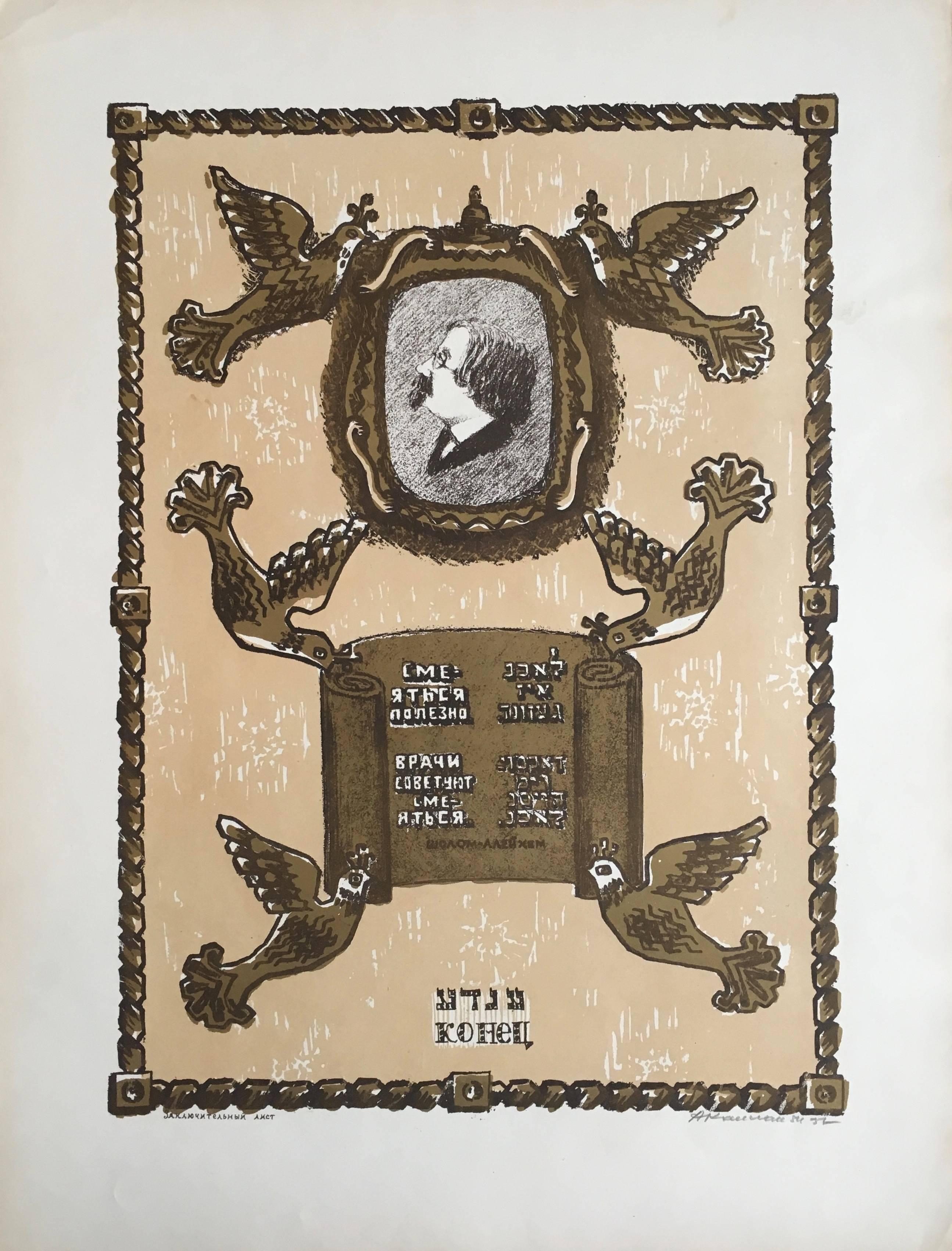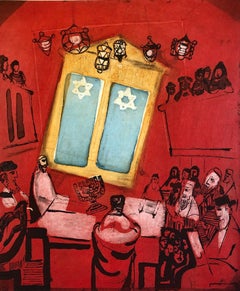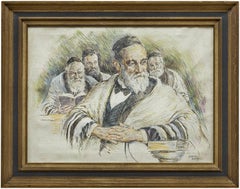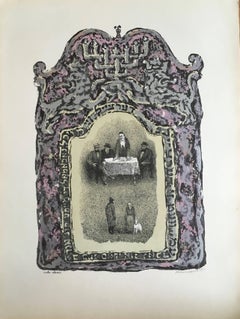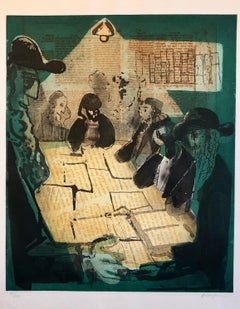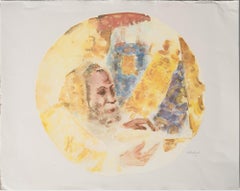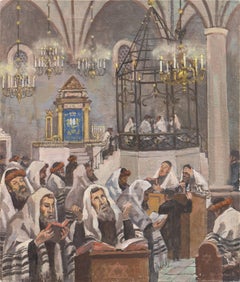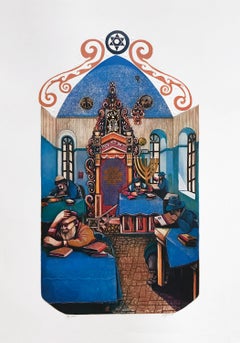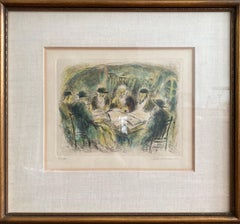Items Similar to A Fine Judaica Etching "Atonement" Yom Kippur in the Synagogue
Want more images or videos?
Request additional images or videos from the seller
1 of 7
Samuel George CahanA Fine Judaica Etching "Atonement" Yom Kippur in the Synagogue1950
1950
$650
£506.07
€575.55
CA$935.19
A$1,027.27
CHF 536.86
MX$12,251.05
NOK 6,798.07
SEK 6,332.98
DKK 4,300.75
About the Item
In this copper plate etching, Cahan captures the religious ardor and penitent sentiment shared by the figures in the artwork. The piece is number seventy-six in a series of one-hundred etchings entitled Atonement. Cahan’s heavy use of line, as well as, his ability to convey emotion give the viewer a sensitive but harmonized rendering of Jewish prayer. Dimensions w/Frame: 17 1/2" x 15"
The well-known twentieth century American illustrator, etcher, and painter Samuel George Cahan was born in Kovno, Russia, now part of Lithuania. His parents were both born in Russia during the early 1870’s. Two years after his birth, his family emigrated to America and eventually settled in New York City's Lower East Side. Cahan said that his interest for drawing started when he was only an infant. In a 1967 interview, the artist describes his primary school years as vastly disinteresting. While other students heeded their teachers or studied math, Cahan drew.
At 12-years-old, Cahan exhibited his early talent for drawing on Fulton Street’s sidewalk. Barefoot and armed with chalk, he crouched outside a restaurant and drew the sinking of Maine. At the time, it was recognizable ship that was smashed by the British. One of the men who passed by his vibrant rendering of the wreckage was the Chief Editor of the New York World newspaper, Nelson Hersh. Upon seeing the young boy’s skill, Hersh offered him a job in the newspaper’s art department. During his time at the newspaper, he worked on sketching court trials and learned from other prominent American artists working in the art department, such as George Luks.
After leaving the newspaper, he explored other artistic mediums that combined his love of color and line. From etchings on copper plates, he moved onto watercolor, and finally to oil. As an adult, he began to seriously study Fine art. Cahan first studied with the famous American artist Robert Henri. They would meet in the evenings along with other students including George Bellows and Stuart Davis. He continued his studies at the distinguished Art Students League of New York and eventually became a life member. Throughout his life, he exhibited his work with French & Company Gallery. In addition, he showed his work at the National Academy of Design where he was honored with several awards.
“An artist is not a camera,” was one of Cahan’s favorite mottos. He applied this belief to all his paintings. The artist was a great supporter of Judaism and would often take his inspiration from the Jewish community. Whether landscapes or portraits, many of his works blend his interest in culture, color, and narratives. Cahan uses gestural line and brush strokes to create emotion masterpieces that connect to broad audiences. Although Cahan died in 1974, he left a legacy of artworks that chronicle the Jewish community in New York City.
- Creator:Samuel George Cahan (January 11, 1886 - October 23, 1974, American)
- Creation Year:1950
- Dimensions:Height: 17.5 in (44.45 cm)Width: 15 in (38.1 cm)
- Medium:
- Period:
- Condition:
- Gallery Location:Surfside, FL
- Reference Number:1stDibs: LU38211501052
About the Seller
4.9
Platinum Seller
Premium sellers with a 4.7+ rating and 24-hour response times
Established in 1995
1stDibs seller since 2014
1,837 sales on 1stDibs
Typical response time: 1 hour
- ShippingRetrieving quote...Shipping from: Surfside, FL
- Return Policy
More From This Seller
View AllModernist Judaica Art Aquatint Etching Jewish Rabbi at Prayer Jerusalem Memories
By Lennart Rosensohn
Located in Surfside, FL
Swedish Jewish modern art. On Hahnemuhle paper, hand signed and numbered. poster is not included.
These depict synagogue interiors, Rabbis at prayer ...
Category
20th Century Modern Figurative Prints
Materials
Etching, Aquatint
Vintage Illustration Judaica Painting, The Rabbi's (Men at Prayers)
By Samuel George Cahan
Located in Surfside, FL
Genre: Judaica
Subject: Religious
Medium: Oil
Surface: Canvas
Country: United States
Dimensions: 24" x 18" x 3/4"
Dimensions w/Frame: 29" x 23"
Cahan uses vibrant oil paint to draw a portrait of four elderly Jewish men wearing prayer shawls also known as tallits. The man in the foreground is staring pensively into the distance while the other figures in the background read or pray. Each character shares the same scholarly air in their serious expressions and mannerisms. Cahan’s gestural use of color and brush strokes soften the painting’s protagonists, thereby shedding a more sensitive light on the painting.
The well-known twentieth century American illustrator, etcher, and painter Samuel George Cahan was born in Kovno, Russia, now part of Lithuania. His parents were both born in Russia during the early 1870’s. Two years after his birth, his family emigrated to America and eventually settled in New York City's Lower East Side. Cahan said that his interest for drawing started when he was only an infant. In a 1967 interview, the artist describes his primary school years as vastly disinteresting. While other students heeded their teachers or studied math, Cahan drew.
At 12-years-old, Cahan exhibited his early talent for drawing on Fulton Street’s sidewalk. Barefoot and armed with chalk, he crouched outside a restaurant and drew the sinking of Maine. At the time, it was recognizable ship that was smashed by the British. One of the men who passed by his vibrant rendering of the wreckage was the Chief Editor of the New York World newspaper, Nelson Hersh. Upon seeing the young boy’s skill, Hersh offered him a job in the newspaper’s art...
Category
Mid-20th Century American Impressionist Figurative Paintings
Materials
Canvas, Oil
VIntage Russian Shtetl Scene, Judaica Lithograph
By Anatoli Lvovich Kaplan
Located in Surfside, FL
Pencil signed and dated, colored Judaica Lithograph.
Anatoli Lwowitch Kaplan was a Russian painter, sculptor and printmaker, whose works often reflect his Jewish origins.
His father...
Category
Mid-20th Century Modern More Prints
Materials
Lithograph
Modernist Judaica Art Aquatint Etching Jewish Rabbi at Prayer Jerusalem Memories
By Lennart Rosensohn
Located in Surfside, FL
on Hahnemuhle paper, hand signed and numbered. poster is not included.
These depict synagogue interiors, Rabbis at prayer etc. Judaic religious events.
Mauritz Lennart Rosensohn , bo...
Category
20th Century Modern Figurative Prints
Materials
Etching, Aquatint
Vintage Russian Shtetl, Scene Judaica Lithograph
By Anatoli Lvovich Kaplan
Located in Surfside, FL
Pencil signed and dated, colored Judaica Lithograph.
Anatoli Lwowitch Kaplan was a Russian painter, sculptor and printmaker, whose works often reflect his Jewish origins.
His father...
Category
Mid-20th Century Modern More Prints
Materials
Lithograph
German Israeli Judaica Havdalah Scene Jewish Shabbat Closing Ceremony
By Hermann Struck
Located in Surfside, FL
Genre: Judaica
Subject: People
Medium: Print
Surface: Paper
size: 13.5 X 10.5, 17.5 X 13.75 with mat.
on the Haifa Museum website this piece is described as a vernis-mou, aquatint et...
Category
Early 20th Century Modern Figurative Prints
Materials
Etching
You May Also Like
"The Rabbi and the Torah" unframed lithograph hand-signed by artist Chaim Gross
By Chaim Gross
Located in Boca Raton, FL
"The Rabbi and the Torah" unframed lithograph on fine art paper by artist Chaim Gross from a limited edition of 250. Hand signed Chaim Gross and hand numbered 63/250. Image size: 21...
Category
20th Century Modern Portrait Prints
Materials
Lithograph
'Interior of Synagogue with Rabbi', Polish Orthodox Judaica, Israel, Pentateuch
By Mieczyslaw Watorski
Located in Santa Cruz, CA
Signed lower right, 'M. Watorski' for Mieczyslaw Watorski (Polish, 1903 - 1979) and painted circa 1950.
This Polish history and landscape painter is particularly revered for his doc...
Category
1940s Interior Paintings
Materials
Canvas, Oil
YASHIVA IN JERUSALEM (JUDAICA ART)
By Amram Ebgi
Located in Aventura, FL
Embossed lithograph with foil stamping on paper. Hand signed and numbered by the artist. From the edition of 300.
Artwork is in excellent condition. Certificate of authenticity in...
Category
Late 20th Century Contemporary Figurative Prints
Materials
Foil
$100 Sale Price
50% Off
Reading the Torah, Modern Hand Colored Etching by Ira Moskowitz
By Ira Moskowitz
Located in Long Island City, NY
Ira Moskowitz, Polish/American (1912 - 2001) - Reading the Torah, Medium: Hand Colored Etching, signed and numbered, Edition: 5/120, Size: 11 x 13.5 in. (27.94 x 34.29 cm), Frame S...
Category
1960s Modern Figurative Prints
Materials
Etching
Framed Seymour Rosenthal Etching “Elder With Torah”
Located in Delray Beach, FL
This framed Seymour Rosenthal etching, titled "Elder with Torah," beautifully captures the reverence of tradition. The detailed artwork and elegant framing make it a meaningful addit...
Category
Vintage 1970s American Prints
Materials
Wood
The Reading of the Torah
By Charles Bragg
Located in San Francisco, CA
This artwork "The Reading of the Torah" c.1970 is an original etching by noted American artist Charles Bragg, 1931-2017. It is hand signed and numbered XV/XXXV in pencil by the artis...
Category
Late 20th Century Other Art Style Figurative Prints
Materials
Etching
